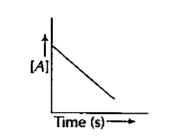Examine the given defective crystal :
X+Y−X+Y−X+Y−OY−X+Y−X+Y−X+OX+Y−X+Y−X+Y−
Answer the following questions.
Write the term used for this type of defect. Give an example of the compound which shows this type of defect.Solution in Odia
The term used for this type of defect is Schottky defect. This defect arises when equal number of cations and anions are missing from their lattice sites such that electrical neutrality is maintained. These defects are vacancy defects shown by ionic solids in which the anion and cation are nearly of the same size.
Examples are NaCl are KCl show Schottky defect.
Topper's Solved these Questions
- SAMPLE PAPER 1 BOOK - ARIHANT PUBLICATIONCHAPTER - SAMPLE PAPER 1 EXERCISE - GROUP C
14 Videos
- SAMPLE PAPER 1 BOOK - ARIHANT PUBLICATIONCHAPTER - SAMPLE PAPER 1 EXERCISE - GROUP A
7 Videos
- QUESTION PAPER 2019BOOK - ARIHANT PUBLICATIONCHAPTER - QUESTION PAPER 2019EXERCISE - GROUP C
11 Videos
- SAMPLE PAPER 4 BOOK - ARIHANT PUBLICATIONCHAPTER - SAMPLE PAPER 4 EXERCISE - GROUP C
7 Videos
Similar Questions
A strip of nickel metal is dipped in a 1 molar solution of Ni(NO3)2 and a strip of silver metal is dipped in a 1 molar solution of AgNO3. An electrochemical cell is created when the two solutions are joined by salt bridge and two strips are joined by wire to a voltmeter.
Answer the following questions.
Write the balanced equation for the overall cell reaction and calculate the cell potential.
View SolutionWhich noble gas is used in atomic reactor ?
View SolutionWhat are oil in water and water in oil type of emulsions ? Give one example of cach type.
View SolutionConsider the reaction, Ak−−→P. The change in the concentration of A with time is shown in the following plot:

(a) Derive the expression for the time required for the completion of the reaction.
(b) Predict the order of the reaction.
View SolutionExamples :- If x,y∈{1;2;3;4} ;then which of the following are function in the given set ? (a)f1={(x;y):y=(x+1)}(b)f2={(x;y):x+y>4}(c)f3={(x,y):y
View SolutionExamine the given defective crystal {:(X^(+),Y^(-),X^(+),Y^(-),X^(+)),(Y^(-),Z^(2+),Y^(-),X^(+),Y^(-)),(X^(+),Y^(-),O,Y^(-),X^(+)),(Y^(-),X^(+),Y^(-),X^(+),Y^(-)):} (i) Write the term used for this of defect . (ii) What is the result when XY crystal is doped with divalent (Z^(2+)) impurtiy ?
View SolutionExamine the given defective crystal {:(X^+, Y^-, X^+, Y^-, X^+),(Y^+, Z^(2+), Y^- , X^+, Y^-),(X+ , Y^- , O, Y^- , X^+),(Y^-, X^+, Y^- , X^+, Y^-):} (i)Write the term used for this type of defect (ii)What is the result when XY crystal is doped with divalent (Z^(2+)) impurity ?
View Solutionदिए गये दोषपूर्ण क्रिस्टल का परीक्षण कीजिए
X+Y−X+Y−X+Y−OY−X+y−X+Y−X+OX+Y−X+Y−X+Y−
निम्नलिखित प्रश्नों के उत्तर दीजिए
उपर्युक्त दोष रससमीकरणमितीय (स्टॉइकियोमीट्रिक) है या अरससमीकरणमितीय (अन-स्टॉइकियोमीट्रिक)
View Solutionदिए गये दोषपूर्ण क्रिस्टल का परीक्षण कीजिए
X+Y−X+Y−X+Y−OY−X+y−X+Y−X+OX+Y−X+Y−X+Y−
निम्नलिखित प्रश्नों के उत्तर दीजिए
इस प्रकार के दोष को किस पद से लिखते हैं ? एक यौगिक का उदाहरण दीजिए जो इस प्रकार का दोष दर्शाता है।
View Solutionदिए गये दोषपूर्ण क्रिस्टल का परीक्षण कीजिए
X+Y−X+Y−X+Y−OY−X+y−X+Y−X+OX+Y−X+Y−X+Y−
निम्नलिखित प्रश्नों के उत्तर दीजिए
इस प्रकार के दोष से क्रिस्टल के घनत्व पर क्या प्रभाव पड़ता है ?
View SolutionIf xy=yx show that (xy)xy=xxy−1 if further x=2y then prove that y=2
View Solutionদেখাও
(xy)xy=x(xy)−1 যদি xy=yx হয় এবং যদি x=2y হয় তবে দেখাও যে y=2
View SolutionThe equation of the normal to the curve y=sinx at the point (π,0) is:
O x+y=π
O x+y+π=0
O x−y=π
O x−y+n=0
View SolutionExamine the given defective crystal :
X+Y−X+Y−X+Y−OY−X+Y−X+Y−X+OX+Y−X+Y−X+Y−
Answer the following questions :
(i) Is the above defect stoichiometric or non-stoichiometric ?
(ii) Write the term used for this type of defect. Give an example of the compound which shows this type of defect.
(iii) How does this defect affect the density of the solid ?
View SolutionExamine the given defective crystal :
X+Y−X+Y−X+Y−X+Y−X+Y−X+Y−X+e−X+Y−X+Y−X+Y−
Answer the following questions :
(i) Is the above defect stoichiometric or non-stoichiometric ?
(ii) Write the term used for the electron occupied site.
(iii) Give an example of a compound which shows this type of defect.
View SolutionExamine the given defective crystal {:(X^(+),Y^(-),X^(+),Y^(-),X^(+)),(,X^(+),,, ),(Y^(-),O,Y^(-),X^(+),Y^(-)),(X^(+),Y^(-),X^(+),Y^(-),X^(+)),(Y^(-),X^(+),Y^(-),X^(+),Y^(-)):} Answer the following questions : (i) Is the above defect stoichiometric or non-stoichiometric ? (ii) Write the term used for this type of defect. (iii) Why do silver halides show this type of defect ?
View Solution
